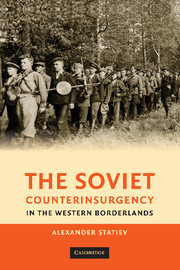Book contents
- Frontmatter
- Contents
- List of Figures
- List of Tables
- Acknowledgments
- Glossary
- Introduction
- 1 Origins of Soviet Counterinsurgency
- 2 The Borderland Societies in the Interwar Period: The First Soviet Occupation and the Emergence of Nationalist Resistance
- 3 The Borderlands under German Occupation (1941–1944): Social Context of the Soviet Reconquest
- 4 Nationalist Resistance after the Soviet Reconquest
- 5 Soviet Agrarian Policy as a Pacification Tool
- 6 Deportations, “Repatriations,” and Other Types of Forced Migration as Aspects of Security Policy
- 7 Amnesties
- 8 Red Rurales: The Destruction Battalions
- 9 Police Tactics: Actions of NKVD Security Units, Intelligence Gathering, Covert Operations, and Intimidation
- 10 The Church in Soviet Security Policy
- 11 Violations of Official Policy and Their Impact on Pacification
- 12 Conclusion: Nationalist Resistance and Soviet Counterinsurgency in the Global Context
- Appendix A Note on Used Terms and Geographic and Personal Names
- Appendix B Note on Primary Sources
- Bibliography
- Index
12 - Conclusion: Nationalist Resistance and Soviet Counterinsurgency in the Global Context
Published online by Cambridge University Press: 05 May 2010
- Frontmatter
- Contents
- List of Figures
- List of Tables
- Acknowledgments
- Glossary
- Introduction
- 1 Origins of Soviet Counterinsurgency
- 2 The Borderland Societies in the Interwar Period: The First Soviet Occupation and the Emergence of Nationalist Resistance
- 3 The Borderlands under German Occupation (1941–1944): Social Context of the Soviet Reconquest
- 4 Nationalist Resistance after the Soviet Reconquest
- 5 Soviet Agrarian Policy as a Pacification Tool
- 6 Deportations, “Repatriations,” and Other Types of Forced Migration as Aspects of Security Policy
- 7 Amnesties
- 8 Red Rurales: The Destruction Battalions
- 9 Police Tactics: Actions of NKVD Security Units, Intelligence Gathering, Covert Operations, and Intimidation
- 10 The Church in Soviet Security Policy
- 11 Violations of Official Policy and Their Impact on Pacification
- 12 Conclusion: Nationalist Resistance and Soviet Counterinsurgency in the Global Context
- Appendix A Note on Used Terms and Geographic and Personal Names
- Appendix B Note on Primary Sources
- Bibliography
- Index
Summary
I have pursued four goals in this book. First, I have addressed the nature of the conflict in the western borderlands. Second, I have made a comparative analysis of the anti-Soviet resistance movements and outlined their goals, strategies, composition, strengths and weaknesses, and relations with the population. Third, I have conceptualized the Soviet pacification doctrine, showed the means that the state used against insurgents, and examined the problems connected with implementation of the intended policy. I proceed now to my last objective: to highlight the peculiarities of nationalist resistance and Soviet counterinsurgency in the global context.
Popular resistance is an important part of national mythology. Glossy images of an audacious maqui, a Robin Hood–style haidut, and a simple but proud Zapatista are cherished by the French, Balkan, and Mexican nations, whose governments promote legends about these personages in order to foster national unity. Fences in Chihuahua greet visitors with the slogan, “Viva Villa!”; the monuments to antifascist partisans in Bulgaria outnumber the actual participants in the resistance against a Bulgarian regime that was anything but fascist; and the inhabitants of La Higuera Village who betrayed the location of Ernesto Guevara's band to a military unit extol the famous guerrillero in conversations with frequent pilgrims. Italian leftists still march to Bella ciao during their street rallies; Geronimo became a favorite Hollywood personage; towns of the Gaza Strip proudly display huge images of shaheeds who blew themselves up in Israeli buses; only rare parties in Macedonia proceed without a song about Iane Sandanski; and entrepreneurs in Chiapas make handsome profits by selling kitschy T-shirts with pictures of subcomandante Marcos.
- Type
- Chapter
- Information
- The Soviet Counterinsurgency in the Western Borderlands , pp. 310 - 338Publisher: Cambridge University PressPrint publication year: 2010



